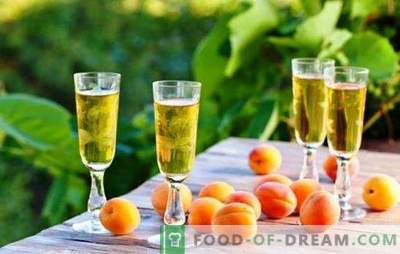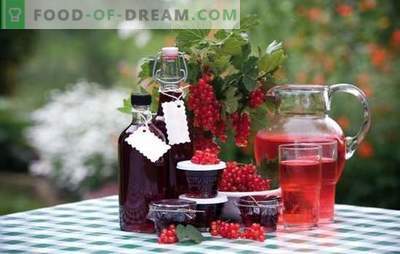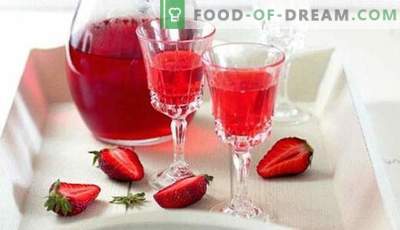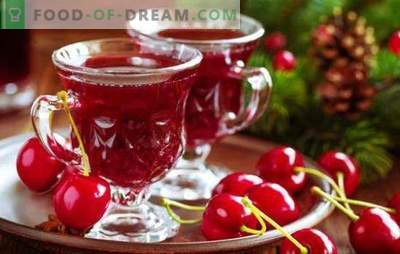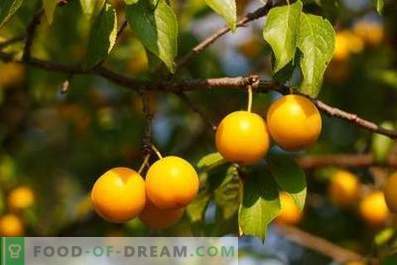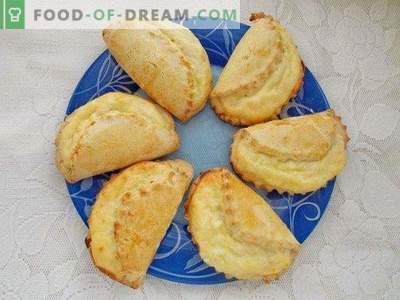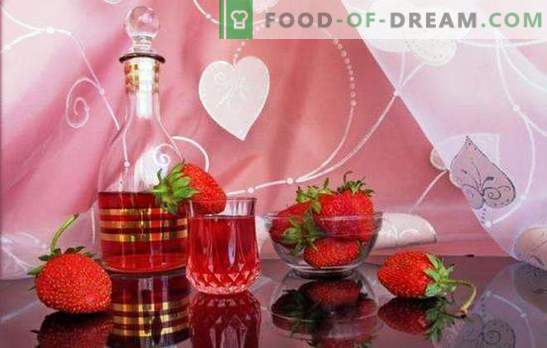
With all the wealth and diversity of fruit and berry crops on the planet, perhaps, only strawberries are the main and favorite ingredient of chefs all over the world when it comes to making dessert for a romantic dinner. In addition, you can serve the same aromatic wine to emphasize the taste of the dessert and the charm of the evening. However, for the preparation of homemade wine from strawberries will need much more time and some experience in home winemaking.
Recipes for homemade strawberry wine - the basic technological principles
Strawberries or strawberries, garden or forest - the ideal berry for making wine.
The positive component is the berry flavor. Strawberry wine can veil the defects of any failed homemade wine so that it seems as if it was intended.
It is fairly easy to get natural juice from strawberries, while the losses will be very minimal compared to other berry materials. But even the oil removed from the natural juice of the cake remains valuable for processing wine materials, a component for the preparation of the juice of the re-drain, berry syrup, tincture or liqueur.
The main attention in winemaking, including homemade, is paid to the presence and percentage of fruits and acids, which are the basis of the wort, as well as a guarantee for preparing high-quality wine and the duration of its storage.
At the normal acid content of 0.7-1.0%, including tartar and tannic, in the finished wine, almost all known strawberry (strawberry) garden varieties correspond to these indicators. But strawberry cultivars have a less pronounced aroma than wild berries, with a higher content of acids (up to 1.2 - 1.3%). Home winemakers, if possible, seek to enhance the flavor of homemade strawberry wine by adding wild berries to the wort, which, accordingly, increases the acid content in the wort. The maximum allowable acid value for the wort is 1.4%. Therefore, there is no particular problem in blending forest and garden berries. The only point that needs to be considered, with a small number of sunny days, some other weather conditions, changes in soil structure, the acid content in strawberries may exceed the permissible rate. In such cases, the problem of increased acid content is eliminated by diluting the juice with water, adding (blending) another, sweeter juice.
But, despite the almost perfect biochemical composition for use in home winemaking, it still has one drawback - there is no tannic acid in this wine material, an important stabilizing component of any wine. To increase the stability and stabilize the taste, tannin (tannic acid) is added after fermentation. As this supplement, you can use tannin, sold in a pharmacy. Tannins are also found in some fruits (bird cherry, quince, persimmon).
The next component of wine must is sugar. Normal fermentation, alcohol content and taste of the finished wine depend on its quantity. Sugar is needed in wine yeast as a source of energy. When it is processed, the fungi form alcohol. More sugar - higher alcohol content of wine. The natural level of sugar content of strawberries is 4-10%. With these indicators you can get a weak and unstable homemade wine from strawberries. The minimum acceptable alcohol content for dry wines is 9%. To increase the strength by one degree, 20 g of sugar per liter is added to the wort.
Sugar is also directly related to wine storage. Sugar protects the drink from the development of microorganisms harmful to wine, acting as a preservative. He also gives stability to wines with low alcohol content. After the termination of the fermentation of sugar is added. Its quantity is regulated by the requirements for the type of drink.
For a weak homemade wine made from strawberries, wild yeast is quite enough, that live on the surface of all fruit and berry crops in natural conditions. But for stronger, dessert and liqueur wines, it is recommended to add wine yeast cultures grown in special artificial conditions to the strawberry wort. In turn, the yeast must be provided with optimal conditions for work. The main thing - the temperature. At the initial stage, when fermenting the wort, its temperature can reach 25 degrees, but t18-22 degrees are considered ideal for wine fermentation. When making homemade wines, you also need to know that the lowest critical temperature for the wort is 14 degrees, and at +10 degrees the wine yeast in the wort dies. At +25 degrees the wort continues to “ferment”, although not very active. Yeast, like all living organisms, react to the environment, their performance decreases in hot conditions. In some cases, when the yeast does not have enough food, ammonium salt (sal ammoniac) is added to the wort.
It remains to add that after receiving the juice, its analysis and improvement of biochemical parameters, adding yeast to it, the whole process of further preparing homemade wine from strawberries consists in fermentation, clarification and removal from sediment, tanning and sweetening, aging and ripening, bottling and storage. As you can see, nothing complicated. You just need to be patient, which is very necessary in winemaking, and try out a few recipes for homemade strawberry wine, at least in small quantities, for a start.
When calculating the required number of berries, it is necessary to take into account for obtaining juice that 650-690 ml of natural juice is obtained from 1 kg of strawberry garden pineapple; from the forest - 600-620 ml.
1. The recipe for homemade wine from strawberries garden and forest: dessert wine
Composition:
- Strawberry 6.5 kg
- Wild strawberries, forest 5.0 kg
- Sugar 4.1 kg
- Wine yeast 3 g
- Tannic acid 20 g
- Wine stone 16 g
Cooking Technology:
Fresh berries sort out, remove the sepals, not mine, put under the press. Squeezed berries can be used for making tinctures.
Cooked sugar is introduced into the wort parts, so the required amount should be divided into parts: 1.1 kg of sugar is introduced into the wort initially, dissolving it in fresh squeezed strawberry juice and adding tartaric acid; Pour thus prepared wort into a glass bottle, filling it with no more than 2/3 volume. Installing a water seal, follow the progress of fermentation.
After completion of the phase of rapid fermentation, when the release of gas bubbles becomes moderate, add another 500 g of sugar, first pouring out a small portion of the wort and dissolving a portion of sugar in it. Sugar should not settle to the bottom of the bottle - it is necessary that he immediately involved in the process.
Continue adding sugar in portions every 5–7 days of fermentation. The remaining portion (0.5 kg) should be added only after the finished young wine will be removed from the sediment and clarified. To do this, you need to pour a small portion of wine again, dissolve tannin in it and mix with the total mass. Allow the wine to withstand the transparency of ido, again pour into a clean container. Add the last portion of sugar, stir until dissolved. After the wine must be allowed to ripen within 2-3 months. Watch him. Further care is to transfuse the wine (once every two weeks). If the wine is stored in bottles, then put them in the basement on the shelves horizontally, so that the corks are wet.
2. Recipe for homemade strawberry wine. Liqueur wine
Composition:
- Strawberry juice 7.0 l
- Sugar 5.1 kg
- Tartaric acid 70 g
- Tannin 30 g
- Yeast, wine 5 g
Preparation Method:
2.1 kg of sugar are left to sweeten liqueur wine at the final stage of preparation; 3.0 kg are divided into two equal parts. 1.5 kg of sugar along with tartar and yeast dissolve in fresh juice. The juice is poured into the bottle, leaving 1/3 of the free space for fermentation and then adding sugar. When the first signs of fermentation (foaming of the surface of the wort) appear, a water seal is installed. The next part of the sugar is added no earlier than 10 days after the subsidence of the most active fermentation phase. The clarification of the wort and sedimentation at the bottom of the tank indicates that it is time to remove the wine from the sediment, add tannin and the last part of the sugar. To do this, dissolve 2.1 kg of sugar with constant stirring along with tannin. Pour the wine into a clean bottle. The shutter can be removed by closing the wine stopper or lid. When the wine is completely transparent, pour it again, removing the sediment, and transfer the liqueur wine to the cellar for storage. Control moisture in the basement. Twice a month it is better to pour wine. After 4 months, the wine can be bottled and sealed. After a year of storage, it will acquire tea color, retaining the strawberry bouquet.
3. Recipe for homemade strawberry wine. Fortified wine
Composition:
- Juice, natural strawberry 6.9 l
- Sugar 1.4 kg (+ 1.2 kg for sweetening)
- Vodka (40%) 0.75 l
- Oak leaves
Preparation Procedure:
At the time of fermentation of wine put tincture of oak leaves on vodka for extraction. In the same dish, you can add the thick, remaining on receipt of strawberry juice, to enhance the aroma of fortified wine. In a liter jar, place fresh, washed and slightly dried, chopped oak leaves. Close the jar tightly and place in a warm place. Do not forget to shake it periodically to enhance the extraction. When the wine is ready, the tincture must be filtered to connect it with the young wine and fix it, completely stopping the fermentation.
Combine sugar and strawberry juice in an enamel pot, stir well and pour the prepared wort into the fermentation bottle. After the foam appears, seal the bottle with the shutter and wait until the fermentation stops. Allow the young wine to stand for two weeks to precipitate fell to the bottom. Pour the wine by removing the sediment. Do this carefully so as not to stir up the settled particles.
The sediment can be used as a starter for domestic wines from fruits of a later ripening period. Sweeten the removed young wine by adding the second part of the prepared sugar, pour in the prepared and purified tincture. Put for exposure not less than a month. Store it in a cool basement. Repeat stripping and bottle.
4. Recipe for homemade strawberry wine. Strong table wine
- Composition:
- Garden strawberries, pineapple 14 kg
- Sugar 1.6 kg
- Tannin 75g
Preparation Method:
Mature, selected berries to knead and combine with sugar. After a day, pass the fermented juice through a tight filter and pour it into the prepared bottle. Seal the wort with the shutter and, placing it in a suitable place, wait until the fermentation stops and the wine yeast has settled to the bottom. Add in new wine tannin. In a few days, it should become more transparent. Again, remove the young wine from the sediment and pour it into another sterile bottle, which you then transfer for aging and ripening in a cool room (12-14 degrees).
5. A simple recipe for homemade strawberry wine. Dry table wine
Composition:
- Garden berries juice 8.5 l
- Forest strawberry 9.0 kg
- Sugar 2.4 kg
Preparation:
Sort wild berries, chop and add strawberries along with sugar to the juice of the garden. Put the fermentation mash at 25 degrees, and then pour into the bottle. Install the shutter. All further stages of making wine are described in the previous recipe.
Tip: so that dry wine is more resistant to disease during storage, put a linen bag filled with oak bark in the bottle in which it will be stored in the basement.
6. Recipe for homemade strawberry wine. Sparkling semisweet wine Muscat
Composition:
- Forest and garden strawberries (1: 1) 10 kg
- Sugar 2.5 kg
- Nutmeg, crushed 30 g
Preparation Procedure: From the prepared berries make pulp, adding to it 2 kg of sugar. Filter the fermented pulp, pour the resulting juice into the bottle and add the ground nutmeg. Close the neck with the shutter. Combine the finished, clarified young wine with the rest of the sugar, stir and pour into champagne bottles. Carefully cork. Soak bottles for 24 hours at room temperature, and then transfer them to the basement. Lay horizontally and store at 10-14 degrees. You can taste sparkling wine no earlier than six months.
Strawberry Homemade Wine Recipes - Tips and Tricks
- Natural corks for sealing wine can be reused. To seal a bottle of good homemade wine, fill the corks with boiling water and wait until they are soft. Seal bottled wine. After, if the used traffic jams have through holes left by the corkscrew when unpacking, pour them with melted beeswax, wrap the neck with tape.
- Be sure to label homemade wine left for aging. It is necessary to indicate on the labels the type of wine, strength (sugar content), date of manufacture. The home wine cellar can and should be better than the most famous in the world.

